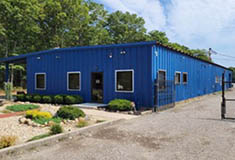Commercial Classroom: Green update - by Edward Smith Jr.

The sun produces radiation, if we get too much sun we get sunburned. Our planet is surrounded by atmosphere, part of which is known as the ozone layer. This ozone layer blocks 90+% of the sun’s radiation from reaching earth.
We have been burning fossil fuels since the beginning of mankind. They create greenhouse gases, predominately carbon dioxide also known as carbon emissions. The power plants that produce electricity, the systems that heat and cool our buildings, the planes, trucks, and automobiles we use for transportation all create carbon emissions. These emissions punch holes in the ozone layer allowing more of the sun’s radiation and heat to reach our planet.
The result is an increase in the temperature of the earth and the extreme weather patterns that we are seeing. We are literally seeing the north and south polls starting to melt which increases the depth of our oceans, creating more powerful storms.
Our country and many other countries are finally doing things to reduce carbon emissions. California now has dictated that all new homes be built with solar power. New Your City has created a cap on carbon emissions for all buildings over 25,000 s/f, with significant fines if not in compliance.
We now see solar panels everywhere. When the sun shines onto a solar panel, energy from the sunlight is absorbed by photovoltaics (PV) cells in the panel. This energy creates electrical charges that move in response to an internal electrical field in the cell, causing electricity to flow. Solar equipment has come a long way and now makes economic sense.
Solar power is now being used by many municipalities, Rhode Island has set an example by using solar power on all of its state office buildings. Rhode Island also passed their Green Buildings Act in 2022 mandating that all state and Local buildings, built with taxpayer dollars, over 10,000 s/f must be LEED certified.
Private companies like Apple have gone solar. Its new corporate headquarters, a four-story building of 2,800,000 s/f, is totally solar powered, as are their huge data centers. One center is 500,000 s/f with over 200,000 servers powered and cooled by three adjacent solar farms.

We have seen the many farms that have stopped growing crops and have been converted into producing solar energy. Now Germany has developed vertical solar panels which will allow the farms to continue to grow crops while simultaneously collecting sunlight to create electricity.
The first vertical solar farm in the U. S. is now being developed in Vermont. It will cover 3.7 acres incorporating 69 vertical rack structures each equipped with two bifacial solar modules, spaced 30 ft. apart. The rows will feature crops like carrots, beetroot and saffron planted in between the solar installations.
Indoor farming gives the advantage of being able to grow crops 365 days a year. Metro Crops converted an old factory building in Bridgeport, Conn. to grow lettuce, kale, arugula, and other produce year-round. In Providence, R.I. Gotham Greens converted a former 100,000 s/f GE manufacturing plant, where they made light bulbs, into a sustainable greenhouse. They use hydroponics to grow their greens, using less land, less water, and less energy.
Wind Power started in the Northeast in 2016, with five offshore turbines creating 30 megawatts of power for homes in Rhode Island. In 2021 two other wind energy projects were approved. The South Fork wind farm will be located 32 miles east of Montauk Point, New York, consisting of 12 wind turbines to provide power to 70,000 homes. The Vineyard Wind project is being built off of Martha’s Vineyard, Mass., and will consist of 62 wind terminals. Construction is expected to be completed in 2024.
In 2023 the U.S. Department of the Interior approved the Revolution Wind Project also offshore of Rhode Island. This will include the construction of 65 wind turbines to power 250,000 homes. Recently the Interior Department Bureau of Ocean Energy Management approved the construction of Ocean Wind 1, 13 nautical miles southeast of Atlantic City, New Jersey. This will consist of 98 wind turbines and three offshore sub-stations to bring the electricity to shore.
New York State has recently passed the All-Electric Buildings Act, the first statewide law of its kind in the nation. It outlaws natural gas and other fossil fuel hookups in all new houses and buildings with fewer than seven stories beginning January 1, 2026, and in all new construction by 2029. The end goal being to phase out gas appliances. But there are two problems. The law is being challenged, a lawsuit was filed by 13 plaintiffs including unions, the National Gas and Propane Association and the National Association of Home Builders. The other question is will the power companies be able to provide the necessary electricity?
We have previously written about the droughts in California and the Southwest. At the end of 2023 and into this year the area has experienced extreme amounts of rain and snow fall, deemed a weather condition called Atmospheric Rivers. This has increased the depth of the reservoirs in Nevada and Arizona considerably but not nearly to full capacity. Concern being for what this summer will bring. California, however, has gotten even more rain, and they are now saying that they expect to be drought free into 2025.
Edward Smith Jr. CREI, ITI, CIC, GREEN. MICP, CNE, e-PRO and CIREC program developer, is a commercial and investment real estate instructor, author, licensed real estate broker, speaker, and a consultant to the trade.
Suffolk County IDA supports expansion of A&Z Pharmaceuticals


The evolving relationship of environmental consultants and the lending community - by Chuck Merritt
When Environmental Site Assessments (ESA) were first part of commercial real estate risk management, it was the lenders driving this requirement. When a borrower wanted a loan on a property, banks would utilize a list of “Approved Consultants” to order the report on both refinances and purchases.








.gif)
.jpg)